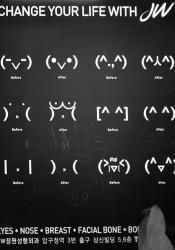Popularization of Plastic Surgery in South Korea
In Patricia Park’s Re Jane, Jane travels from the United States to South Korea upon the death of her grandfather. Having decided to stay in South Korea, Jane travels to a job interview and points out a subway advertisement that “shouted, BECOME THE PERFECT BEAUTY! with side-by-side pictures of a woman’s face,” and she realizes that it was for a plastic-surgery clinic, going on to note that one picture “did not look like a Korean face at all” and had “big, round, double-lidded eyes” (Park 162). Although Re Jane takes place in the early 2000s, this particular moment sheds light on the complex history and relationship South Korea has with the normalization of plastic surgery, specifically the double-eyelid procedure.
The popularization of this procedure, also known as blepharoplasty, in Korea dates back to the 1950s, particularly the years surrounding the Korean War and the U.S. military’s presence in the country (Kurek). Although scholars note that double-eyelid operations were already being developed and performed by surgeons throughout the late 1800s in Japan, many studies point to Dr. David Ralph Millard as “the one to revolutionize and popularize the operation” during his yearlong visit to Korea as U.S. Marine Corps’ chief plastic surgeon in 1954 (Kurek). According to Kurek, Millard provided reconstructive surgery for wounded soldiers and developed cleft palate treatment while also treating many patients who were women; he later published two articles on his Asian eye operation in 1955 and 1964, both of which seem to suggest an aim to westernize Asian beauty standards and the faces of his Korean patients. During the 1960s, more clinics throughout Korea offered the procedure, and by the 1990s, Western media outlets released stories about the industry’s growth as Seoul transformed into the “worldwide mecca of plastic surgery” (Kurek).
Although blepharoplasties seem to “utilize Western ideals to reverse the effects of the Asian face” and are currently sitting alongside rhinoplasties as some of the most prominent operations in South Korea, Sophie Jin notes that the continued prevalence of plastic surgery can be traced back to Korea’s culture and the tradition of physiognomy, “where facial features are thought to be linked to one’s fortune or character.” With Re Jane taking place in the early 2000s, readers witness the significance of these ideologies as they pervade not only through Jane’s observations of the advertisements littering metro stations but also the comments she receives on her appearance in social interactions with friends, family, and potential employers. After having a few drinks, Jane’s friend, Monica, claims that Jane is “so lucky” because she “has the white skin, big eyes, big nose, small chin, long legs” (Park 187). Monica emphasizes features commonly associated with Western influence and assigns Jane with fortune for having them. Later in Park’s novel, Emo takes Jane shopping then nods with approval at Jane’s makeover, telling her that “if [her] Emo looked like [her],” she’d be married (187).
Much like Brontë’s Jane Eyre, Jane Re sheds light on Jane’s experience navigating the pervasive culture of beauty surrounding her in Korea. Having her perception of her own physical appearance and her ability to succeed influenced by these pressures serve as a glimpse into South Korea and its popularization of cosmetic procedures, something that in recent years, according to Elise Hu, has received pushback that resulted in Seoul Metro announcing that it will ban plastic-surgery-related advertisements at its stations.
Works Cited
Hu, Elise. "In Seoul, A Plastic Surgery Capital, Residents Frown on Ads for Cosmetic Procedure." NPR, 5 Feb. 2018, https://www.npr.org/sections/parallels/2018/02/05/581765974/in-seoul-a-p.... Accessed 1 April 2022.
Jin, Sophie. "Plastic's Past: The Complex Historical and Cultural Influences Underlying South Korea's Plastic Surgery Phenomenon." Synergy: The Journal of Contemporary Asian Studies, 7 Oct. 2020, https://utsynergyjournal.org/2020/10/07/plastics-past-the-complex-histor..., Accessed 1 April 2022.
KSU MAIGC. "South Korea, MAIGC'14." Flickr, 11 May 2014, https://flic.kr/p/pk6eBR. Accessed 3 April 2022.
Kurek, Laura. "Eyes Wide Cut: The American Origins of Korea's Plastic Surgery Craze." Wilson Quarterly, 2015, https://www.wilsonquarterly.com/quarterly/transitions/eyes-wide-cut-the-.... Accessed 1 April 2022.
Park, Patricia. Re Jane. Penguin Books, 2016.
Woo, David. "Plastic Surgery Advertisement Seoul." Flickr, 6 Mar. 2012, https://flic.kr/p/bnTYJf. Accessed 3 April 2022.


